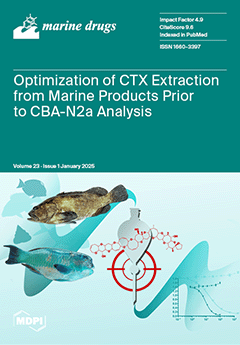A rise in antimicrobial resistance coupled with consumer preferences towards natural preservatives has resulted in increased research towards investigating antimicrobial compounds from natural sources such as macroalgae (seaweeds), which contain antioxidant, antimicrobial, and anticancer compounds. This study investigates the antimicrobial activity of compounds
[...] Read more.
A rise in antimicrobial resistance coupled with consumer preferences towards natural preservatives has resulted in increased research towards investigating antimicrobial compounds from natural sources such as macroalgae (seaweeds), which contain antioxidant, antimicrobial, and anticancer compounds. This study investigates the antimicrobial activity of compounds produced by the Irish seaweed
Alaria esculenta against
Escherichia coli and
Listeria innocua, bacterial species which are relevant for food safety. Microwave-assisted extraction (MAE), ultrasound-assisted extraction (UAE), ultrasound–microwave-assisted extraction (UMAE), and conventional extraction technologies (maceration) were applied to generate extracts from
A. esculenta, followed by their preliminary chemical composition (total phenolic content, total protein content, total soluble sugars) and antimicrobial activity (with minimum inhibitory concentration determined by broth microdilution methods), examining also the molecular weight distribution (via high performance size exclusion chromatography) and oligosaccharide fraction composition (via high-performance liquid chromatography) of the polysaccharides, as they were the predominant compounds in these extracts, aiming to elucidate structure–function relationships. The chemical composition of the extracts demonstrated that they were high in total soluble sugars, with the highest total sugars being seen from the extract prepared with UAE, having 32.68 mg glucose equivalents/100 mg dried extract. Extracts had antimicrobial activity against
E. coli and featured minimum inhibitory concentration (MIC) values of 6.25 mg/mL (in the case of the extract prepared with UAE) and 12.5 mg/mL (in the case of the extracts prepared with MAE, UMAE, and conventional maceration). No antimicrobial activity was seen by any extracts against
L. innocua. An analysis of molar mass distribution of
A. esculenta extracts showed high heterogeneity, with high-molecular-weight areas possibly indicating the presence of fucoidan. The FTIR spectra also indicated the presence of fucoidan as well as alginate, both of which are commonly found in brown seaweeds. These results indicate the potential of antimicrobials from seaweeds extracted using green technologies.
Full article






